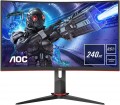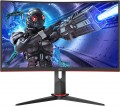Colour depth
The colour depth supported by the monitor.
This parameter characterizes the number of shades that the screen can display. And here it is worth recalling that the image in modern monitors is based on 3 basic colours — red, green, blue (RGB scheme). And the number of bits is indicated not for the entire screen, but for each base colour. For example, 6 bits (the minimum colour depth for modern monitors) means that the screen is capable of producing 2 ^ 6, that is, 64 shades of red, green and blue; the total number of shades will be 64 * 64 * 64 = 262,144 (0.26 million). An
8-bit colour depth (256 shades for each base colour) already gives a total of 16.7 million colours; and the most advanced modern monitors support
10-bit colour, allowing you to work with more than a billion shades.
Screens with support for FRC technology are worth a special mention; nowadays, you can find models marked "
6 bit + FRC " and "
8 bit + FRC ". This technology was developed to improve picture quality in situations where the incoming video signal has a greater colour depth than the screen, such as when 10-bit video is fed to an 8-bit matrix. If such a screen supports FRC, the picture on it will be noticeably better than on a regular 8-bit monitor (although somewhat worse than on a full-fledged 10-bit monitor, but “8 bit + FRC” screens are much
...cheaper).
High colour depth is important primarily for professional graphics and other tasks that require high colour fidelity. On the other hand, such features significantly affect the cost of the monitor. In addition, it is worth remembering that the quality of colour reproduction depends not only on the colour depth, but also on other parameters — in particular, colour gamut (see below).Screen swivel
The presence of
a swivel stand in the design of the monitor allows you to change not only the angle of the screen (of course everyone has it), but also its rotation to the right and left. The angle of rotation depends on the model, but anyway, even a slight deviation allows you to quickly adjust the position of the monitor to your needs.
Speakers
The presence of the monitor's own
built-in speakers. Such models, in fact, combine a screen and speakers, which can save the user from having to purchase separate acoustics. And for models with a TV tuner (see above), this function is almost mandatory. However note that the power of such speakers and the quality of their sound are relatively low, so such a system is hardly suitable for demanding listeners. Nevertheless, built-in acoustics usually sound at least as good as inexpensive external speakers, and take up much less space.
Sound power
Rated power of the speakers installed in the monitor (see "Built-in speakers"). The higher the power, the louder the acoustics can sound, the easier it is to cover a vast space. However, in most cases, the user is directly in front of the monitor, and high volume is not required for normal hearing. So this parameter is critical mainly for plasma and LCD panels (see "Type").
USB hub 3.x
The monitor has a USB hub with USB 3.2 connectors.
A USB hub is a set of additional USB ports on the monitor case, to which you can connect various peripherals (provided that the monitor is connected to the computer's USB port with a special cable). This equipment performs two useful functions. Firstly, the hub increases the number of ports available for connection: the USB cable from the monitor occupies only one port on the computer, and in return the user receives several connectors on the monitor. Secondly, these connectors are located in close proximity to the user, literally at arm's length. This is especially useful when working with classic PCs, where the system unit can be located under the table or in another hard-to-reach place, and it would be inconvenient to reach for it every time in search of USB ports.
As for version 3.2, it combines all versions of the third generation. In fact, this standard includes three specifications: USB 3.2 Gen 1 (formerly USB 3.0) with speeds up to 5 Gbps, USB 3.2 Gen 2 (formerly USB 3.1) with speeds up to 10 Gbps and USB 3.2 Gen 2x2 with speeds up to 20 Gb /with. The USB 3.x hub in the monitor can meet any of these specifications, such details should be clarified separately.
Fast charge
Availability in the monitor USB port with function of
fast charging. This connector is used to charge batteries in various gadgets (smartphones, tablets, etc.). It differs from conventional USB ports in increased power supply; in addition, this connector may not support any other functions at all, except for charging.
Note that in modern technology various special technologies can be used to speed up the charging process. So before buying a monitor with this feature, it doesn't hurt to check if it supports any of these technologies and whether they will be compatible with devices that you plan to charge.
Power consumption
Rated power consumption of the monitor. Usually, this item indicates the maximum power that the device can consume during normal operation — that is, the energy consumption at maximum brightness, the highest volume of the built-in acoustics, etc. Actual power consumption can be noticeably lower, however, when choosing, it is still best to focus on the value stated in the specifications.
In general, the lower the power consumption, the more economical the device in terms of electricity consumption (ceteris paribus). In addition, this characteristic can be useful when selecting an uninterruptible power supply for a PC and in other specific situations when it is necessary to accurately determine the power consumption of equipment.

